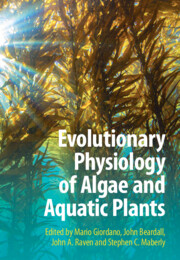Book contents
- Evolutionary Physiology of Algae and Aquatic Plants
- Evolutionary Physiology of Algae and Aquatic Plants
- Copyright page
- Contents
- Contributors
- Preface
- Acknowledgments
- 1 Environmental Changes Impacting on, and Caused by, the Evolution of Photosynthetic Organisms
- Part I Origins and Consequences of Early Photosynthetic Organisms
- 2 Early Photosynthetic Organisms
- 3 …And Nothing Was the Same Anymore: The Rise in O2 and Consequences for Photoautotrophs
- 4 The Appearance of Eukaryotic Microalgae
- 5 The Appearance of Macroalgae: Evolution and Ecological Consequences of Multicellularity
- 6 The Evolution of Aquatic Embryophytes: Secondary Colonisers of Aquatic Environments
- Part II Physiology of Photosynthetic Autotrophs in Present-Day Environments
- Part III The Future
- Index
- References
5 - The Appearance of Macroalgae: Evolution and Ecological Consequences of Multicellularity
from Part I - Origins and Consequences of Early Photosynthetic Organisms
Published online by Cambridge University Press: 24 October 2024
- Evolutionary Physiology of Algae and Aquatic Plants
- Evolutionary Physiology of Algae and Aquatic Plants
- Copyright page
- Contents
- Contributors
- Preface
- Acknowledgments
- 1 Environmental Changes Impacting on, and Caused by, the Evolution of Photosynthetic Organisms
- Part I Origins and Consequences of Early Photosynthetic Organisms
- 2 Early Photosynthetic Organisms
- 3 …And Nothing Was the Same Anymore: The Rise in O2 and Consequences for Photoautotrophs
- 4 The Appearance of Eukaryotic Microalgae
- 5 The Appearance of Macroalgae: Evolution and Ecological Consequences of Multicellularity
- 6 The Evolution of Aquatic Embryophytes: Secondary Colonisers of Aquatic Environments
- Part II Physiology of Photosynthetic Autotrophs in Present-Day Environments
- Part III The Future
- Index
- References
Summary
Multicellularity among algae is not restricted to macroalgae, nor are all macroalgae multicellular. Multicellularity contrasts with colonies of identical cells by differentiation of cell types and intercellular connections; by this definition, heterocystous cyanobacteria are multicellular, as are some freshwater green algae in the streptophyte and chlorophyte lineages. Multicellular, mainly marine, macroscopic algae include Rhodophyta and Phaeophyceae. Among large marine chlorophytan green algae, Ulva has no plasmodesmata, while differentiated Ulvophyceae, such as Acetabularia, Caulerpa, Halimeda and Codium, are composed of a single cell, demonstrating that organ growth and morphogenesis are independent from cell division, so the most complex green seaweeds are both macroscopic and unicellular/acellular. Macroscopic seaweeds of the Rhodophyta, Chlorophyta and Phaeophyceae clades arose from small unicellular ancestors, with the red and green lineages dating back most likely to the Meso- or Neoproterozoic (1,600–900 Ma) and brown seaweeds to about 200 Ma. Compared to benthic microalgae, macroalgae project beyond the substrate boundary layer, but have their own diffusion boundary layer constraining nutrient acquisition, and have more self-shading of photosynthetically active radiation than do individual microalgal cells. These constraints are partly offset by wave activity.
Keywords
- Type
- Chapter
- Information
- Evolutionary Physiology of Algae and Aquatic Plants , pp. 80 - 95Publisher: Cambridge University PressPrint publication year: 2024

